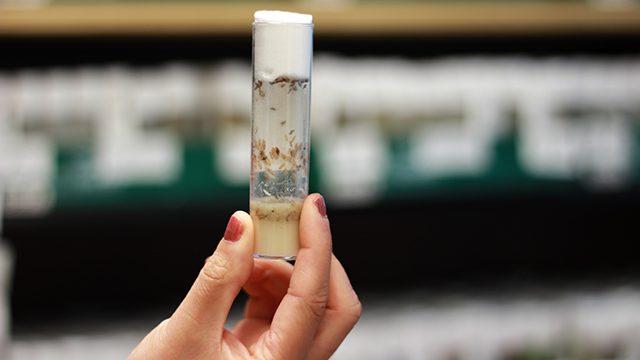
Research associate Francesca Di Cara (front), associate professor Andrew Simmonds and Richard Rachubinski, professor and chair of the Department of Cell Biology, discovered that peroxisomes are necessary for proper functioning of the innate immune system.
A new addition to the fight against bacteria comes in the unlikely form of an organelle that previously had no link to the immune response. University of Alberta researchers have found that peroxisomes are required for cells in the innate immune response to bacteria and fungi.
The discovery was first made in fruit flies. Research Associate Francesca Di Cara, together with Richard Rachubinski, professor and chair of the Department of Cell Biology, and Andrew Simmonds, cell biology associate professor, partnered to create fruit flies that could be used specifically for studying peroxisomal disorders, which are rare genetic diseases affecting humans.
Di Cara found that peroxisomes are necessary for proper functioning of the innate immune system, the body's first line of defense against microorganisms. The innate immune system is an ancient system of immunity that identifies, captures and processes a pathogen, and then presents it to the acquired immune system.
The peroxisomes also communicate to other organs that there is an infection. The team discovered that when the organelle's basic function is altered, this communication is lost and the organism does not fight the bacteria.
"Understanding how the body fights infection has an impact on human health," says Di Cara. "We have to understand who the 'fighters' in the organism are before we can identify what's failing in the battle against bacterial infections."

Peroxisomes are 'chemical factories' that process complex fat molecules into simple forms and modify reactive oxygen molecules, which together act to signal to cells and tissues to respond appropriately to changes in their environment.
Along with their collaborator Nancy Braverman from McGill University, the researchers used a mouse model to confirm that what they observed in the flies also occurred in a mammalian system.
"To find organelles like peroxisomes that had no link whatsoever to fighting bacterial infections was a critical discovery-it will help expand the roles of what this important organelle does in innate immunity against bacterial and fungi, and its involvement in viral signaling and the lethal peroxisome genetic diseases," says Rachubinski. "As the threat of bacterial infections continues to grow, this discovery can help move our understanding of immunity forward."
The work was recently published in Immunity. Funding for project came from Alberta Innovates Collaborative Research and Innovation Opportunities (CRIO) Program and the Canadian Institutes of Health Research.